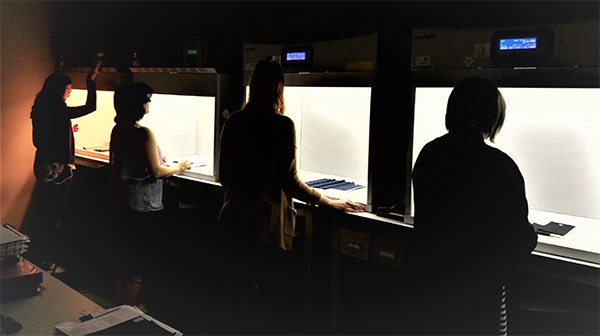“What do you have without color?” asks Halleh Salami. It’s a question that you might find yourself thinking about a little differently after you learn about what she does.
Halleh’s job title at SanMar is “Colorist,” but she made it clear right away that she’s not dyeing hair in a salon. “’Textile Colorist” is probably more like it,” she suggests. As part of our Product Quality Assurance team, Halleh and her colleagues make sure that fabric colors are developed and produced to meet the high standards our customers have come to expect from SanMar.
It’s a job that requires some serious equipment and an eye for detail, and she’s been doing it in some capacity for about 25 years. Like most careers, her evolution has involved a few turns in the road and being in the right place at the right time.
A Future in Color
Halleh earned a degree in Textile Studies at Syracuse University in New York State with an emphasis in weaving. After moving to Seattle, she searched for a career where she could utilize her knowledge of textiles.
The first opportunity presented itself at a career fair facilitated by Eddie Bauer. While gathering information about various jobs, she found herself curious and interested in the QA department. She decided to apply for the testing specialist position. “I loved the testing aspect of that job,” she remembers. She then spent 14 years at Eddie Bauer learning the craft, taking on new positions as QA Engineer and Color Developer, before joining SanMar in September of 2011.
When it comes to the work Halleh does, there’s literally two ways to look at it.
A Recipe for Success
A typical day might find Halleh visually evaluating color in a dark room under controlled lighting and measuring color digitally with a spectrophotometer to validate her visual evaluation. This is a specialized tool that detects the wavelengths of color in a beam of light and returns a specific value for what it sees. “We call it the ‘spectro,’” Halleh says.

While the digital measurement is an important tool in communicating about color with our suppliers, final color comments are always based on visual assessment, ensuring that color is consistent from development to final product. Colorists work closely with fabric suppliers and vendors, making sure SanMar’s color approval processes and requirements are met, so that when you order 200 of those Perfect Weight Tees in Sangria, the color matches on every piece you receive.
Building a strong relationship with our suppliers through guidance, education and trust is crucial. “It’s like your kids,” she says. “You give them the tools and hope they use them well. It’s a recipe for success.”
What Halleh does fulfills the promise Marty Lott made in the early days of SanMar. You might have heard his Yellow T-Shirt Story – achieving color consistency is one way we make sure that what happened to Marty almost 50 years ago doesn’t happen again.
But when you’re talking about color, there’s more to it than looking at the numbers.
Color’s Human Nature
Halleh would be the first to tell you that color perception is very subjective, so it can’t be an exact science. “We’re trained to see slight differences between two shades, that’s our job.” There are a lot of factors to be considered when evaluating color. She believes that even though you review the color in the lightbox, it’s important to think outside the box before making your final color comments.
“Color is a big deal because it’s human nature,” she explains. “It can immediately affect your mood, motivate you or influence you in your actions and decisions.”
She takes pride in her work because for her, color is where clothing comes to life. “The first thing you notice in a piece of clothing is color and if it doesn’t have color it feels like it doesn’t have a soul,” she says.
Halleh enjoys her job at SanMar because it combines what she loves to do with the way she prefers to be. “I have to be happy with what I do and where I am,” she says. “I think every moment that I’m with a group of people I enjoy working with is a good moment.”
She remembers the days before the pandemic fondly, working closely with her team. “All four colorists together in the dark room, evaluating color. The good old days,” she calls it. While things have changed a bit, it’s those same relationships that keep her going. “I find it especially rewarding to collaborate with my cross-functional teams to help them with special projects, resolving issues or coming up with creative ways to improve our processes.”
While processes and requirements have changed over the years to keep up with technology and customer demands, working at SanMar still answers the questions that are most important for Halleh. “Are you being treated well? Are you respected? With SanMar, it’s a two-way relationship. What you put into the job is given back to you. No questions asked.”
